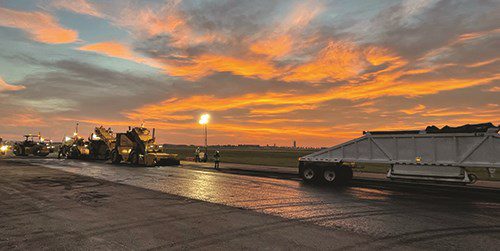Teamwork set the tone for the award-winning rehabilitation of Runway 17R-35L at Colorado Springs Airport completed last summer. And everyone on the team faced a formidable job: milling and overlaying the entire 11,022-foot asphalt surface in just 90 days to avoid working during Colorado’s unpredictable fall and winter weather while minimizing impacts to users.
Teamwork set the tone for the award-winning rehabilitation of Runway 17R-35L at Colorado Springs Airport completed last summer. And everyone on the team faced a formidable job: milling and overlaying the entire 11,022-foot asphalt surface in just 90 days to avoid working during Colorado’s unpredictable fall and winter weather while minimizing impacts to users.
 “Right from the start, we took a team approach to this tremendous task,” says Brett Miller, assistant director of Aviation – Operations and Maintenance at COS. “As soon as [prime contractor] Kiewit joined the team, we held a partnering meeting with RS&H [the engineering consultant] to get all the players aligned around building this work within a very narrow and unforgiving construction window.”
“Right from the start, we took a team approach to this tremendous task,” says Brett Miller, assistant director of Aviation – Operations and Maintenance at COS. “As soon as [prime contractor] Kiewit joined the team, we held a partnering meeting with RS&H [the engineering consultant] to get all the players aligned around building this work within a very narrow and unforgiving construction window.”
As the airport’s second-longest runway, 17R-35L serves a significant portion of its annual enplanements, which reached 936,000 last year. Like all commercial runways in Colorado, it is monitored for deterioration by the Colorado Division of Aeronautics. State personnel use the Pavement Condition Index (PCI), a numeric scale developed by the U.S. Army Corps of Engineers, to quantify the condition of runways and other key airfield surfaces. Using ASTM standardized survey methods, inspectors look for visual indications of distress such as cracking, depressions, bumps and sags, joint reflections, weathering, etc. A PCI score of 0 is the worst; 100 is the best.
“The state comes out every three years and surveys each runway with a third-party engineer,” says Miller. “They walk each runway, looking for cracking, spalling or other distresses…and generate a PCI rating for the pavement. When the degradation number gets below 60, it’s time to start thinking about repaving; 55 or below is considered a poor condition, which obviously can’t go unresolved.”
|
facts&figures
Project: Runway Rehabilitation Location: Colorado Springs Airport Runway: 17R-35L Length: 11,022 ft. Width: 150 ft. (with 30-foot shoulders) Mill Depth: 5 inches Asphalt Overlay: 85,000 tons Pavement Condition Index Ratings: 53 before rehab; 100 after Construction: May through July 2021 Consulting Engineer: RS&H Inc. Prime Contractor: Kiewit Infrastructure Co. Quality Control Testing: Kiewit Infrastructure Co.; Vivid Engineering Inc.
Quality Acceptance Testing: Survey & Grade Control: Edward-James Surveying Minor Crack Repair: A-1 Chipseal
Grooving: Cardinal/International Gate Guard: Cascadia Global Security
Electrical Contractor: Flagging & Haul Route Monitors: Flaggers Inc. Pavement Markings: Hi-Lite Airfield Services
Erosion Control & Landscaping: Asphalt Milling: Western Milling
Asphalt Surface Treatment:
Associated Projects: Upgrading runway lighting to LEDs; relocating PAPI lights; raising wind cones; installing new backup generator, pavement temperature sensors & airfield lighting control regulators; new airfield electrical vault Accolades: 2021 Best in Colorado Award, airport category, from Colorado Asphalt Pavement Association; Quality in Construction recognition from National Asphalt Pavement Association |
Prior to the rehabilitation, 17R-35L was rated a 53. It’s now a perfect 100.
Miller points out that every airport’s runways and infrastructure evolve as they are built, improved, repaired, replaced and rehabilitated. The airfield at COS stretches back to 1927, when its two gravel runways were opened. By 1991, the three-runway configuration still used today was put into place. Since the last full rehabilitation in 2002, 17R-35L and the airport’s other two runways have undergone numerous patch and repair projects.
Planning and Execution
The airport hired RS&H, an architecture, engineering and consulting firm with airfield expertise, to assess the condition of 17R-35L and determine the best way to rehabilitate it. Arlando Gilbert, the firm’s senior project manager for the runway overhaul, notes that RS&H didn’t approach the task with a solution in mind, but rather an investigative, analytical process in hand.
“We walked every inch of the runway,” says Gilbert, a civil engineer who enjoys the massive size, scale and complexity of airfield aviation design. “We commissioned geotechnical exploration, took core samples and did falling weight deflectometer testing to understand what is happening beneath the pavement. We scoured every engineering and construction report from the time it was built through many years of improvements until now.”
Essentially, the project team created a time-lapse portrayal of how the runway was constructed, how and when subsequent layers were added, and its then-current condition.
Based on the findings, RS&H’s recommendation was to mill the top 5 inches of asphalt off the entire length and width of the runway and repave it to create the smoothest possible surface. The complexity of the undertaking was magnified exponentially by Colorado’s notoriously fickle weather. With temperature sheers of 40 degrees possible in a single day, the project team targeted a 90-day construction window during spring/summer to complete the work.
RS&H focused on developing a phasing plan to minimize disruptions for airport tenants and users. This was especially crucial because the airfield would remain operational while crews rehabbed Runway 17R-35L. After the project team submitted a Construction Safety Phasing Plan to the FAA, the agency held a Safety Risk Management Panel to further examine risks and potential impacts to the airfield and airspace around COS.
“Once Kiewit was brought on board, they were able to look at our phasing plan and refine it even further,” notes Gilbert. “They streamlined it piece-by-piece to optimize shutdown windows and crossovers.”

In addition to affecting many private sector users, closing one of the primary runways at COS for three months impacted a key federal tenant, Peterson Space Force Base, located on the northern edge of the airfield.
 Gilbert stresses that collaboration played a key role during the project, which was structured as a bid-build project with the designer and builder contractually independent from one another. Speaking from the engineering firm’s perspective, Gilbert appreciates the effort Kiewit put into its work as the builder.
Gilbert stresses that collaboration played a key role during the project, which was structured as a bid-build project with the designer and builder contractually independent from one another. Speaking from the engineering firm’s perspective, Gilbert appreciates the effort Kiewit put into its work as the builder.
Ryan Konen, the project manager responsible for Kiewit’s performance on the job, had completed two other projects at COS before the recent runway rehab. In his estimation, the company’s Colorado Springs office has become something of a training center for developing its future leaders, and the limited construction window for the expansive 17R-35L project is an excellent example of why.
“This project was bid in April of 2020, but construction didn’t start until May of 2021,” says Konen, noting that most bid-build projects typically don’t have such a long preconstruction period. Beyond the pavement work, the project included several other significant airfield improvements:
- upgrading the runway’s existing incandescent lighting to LEDs
- relocating the precision-approach path indicators (PAPIs)
- raising the supplemental wind cones
- seal-coating the blast pads and runway shoulders
- adding new regulators for the airfield lighting controls
- installing a new flywheel-driven backup generator to eliminate the need to burn diesel fuel during weather-induced power outages
- relocating the airport beacon to increase visibility and enhance safety
“There were some long-lead items and permitting complications that dictated we push construction by a year,” recalls Konen. “It’s important to understand this was 11,000 feet of pavement that is 150 feet wide with 30-foot shoulders, about 210 feet wide altogether. When you add in all the lighting, cabling, navigational equipment, and the critical nature of these systems working perfectly after being installed in just 90 days, it’s a lot to consider.”
The complexities of coordinated shutdowns, the constant need for over-communication and challenges associated with securing and installing specialized navigational lighting are part and parcel with commercial airfield work. But the project team at COS executed them in a manner that garnered state and national recognition.
The Runway 17R-35L project won the 2021 Best in Colorado award, airport category, from the Colorado Asphalt Pavement Association and was recognized for Quality in Construction by the National Asphalt Pavement Association. Konen attributes the accolades to Kiewit’s paving methodology.
 “In terms of creating high-quality asphalt, you want the paver to move as consistently as possible when the material is laid down,” he explains. “We precisely calculated exactly how much of the full width of the runway could be paved in a single shift. This perfectly aligned the asphalt’s longitudinal joints created from each day’s work. As a result, the transverse joints are virtually non-existent The FAA assigns a pay factor based on the quality of the work, and if certain metrics aren’t met, funding is diminished. On this project, we paved a total of 39 shifts, each of which is graded. None of them were rated under 100 percent.”
“In terms of creating high-quality asphalt, you want the paver to move as consistently as possible when the material is laid down,” he explains. “We precisely calculated exactly how much of the full width of the runway could be paved in a single shift. This perfectly aligned the asphalt’s longitudinal joints created from each day’s work. As a result, the transverse joints are virtually non-existent The FAA assigns a pay factor based on the quality of the work, and if certain metrics aren’t met, funding is diminished. On this project, we paved a total of 39 shifts, each of which is graded. None of them were rated under 100 percent.”
In retrospect, Miller says that continually communicating the project’s complexities to stakeholders was as challenging as coordinating and executing them.
“For the airport, communication is the cornerstone of good customer service,” he remarks.
Throughout the project, Miller emphasized the importance of safeguarding the interests of entities that rely on COS to run their businesses. “Though we maintained two crossover points at all times to get west-side tenants to the other runway, shutting down 17R-35L meant more than a mile of taxiing,” he relates. “I can’t say enough about the great team in our Public Information Office who sent out regular updates on what was open, what was closed, and for how long—virtually every day.”
Pilots Like It
With the project complete last summer, Miller is enthusiastic about how the improved runway is impacting the community it serves. “The demand for public infrastructure that keeps people moving immediately turns into jobs whenever the infrastructure is upgraded,” he says of the catalytic stimulus induced by federal investments in airport improvements.
“This project could have been extremely complicated, but the strong commitment to coordination set us up for success,” reflects the 25-year industry veteran. “In the end, airports are about great pavement, which isn’t just nice to have, it’s critical. 17R-35L turned out to be a great project for us. Best of all, the pilots like it.”



